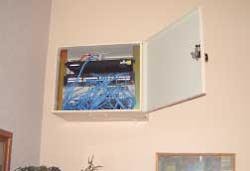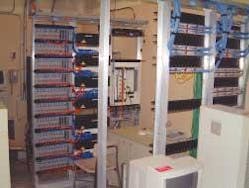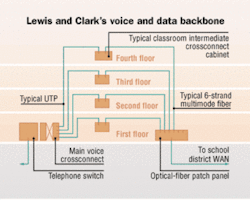How do you successfully incorporate a state-of-the-art telecommunications system in an aging urban high school as part of a total renovation of—and major addition to—the landmark 1912 facility? That was the primary challenge facing NAC Engineering when the company was selected, along with its parent firm Northwest Architectural Company, for the Lewis and Clark High School project in Spokane, WA.
President Theodore Roosevelt laid the cornerstone when the original four-story brick structure, designed in the Gothic style by Spokane architect L.L. Rand, was completed. The school is a beloved part of local history as well as an integral facility of Spokane Public Schools. Time, however, caught up to and surpassed the high school, whose antiquated infrastructure could not accommodate current or future telecommunications technology.
The renovation/addition project had three overriding goals:
- Provide a complete, thoroughly modern learning environment;
- Maintain the building's historic designation;
- Fully integrate telecommunications infrastructure with project design and construction.
That was quite a task, considering the school had never undergone any major improvements during its long life. Its technology system consisted of a plain old telephone system (POTS). Thirty million dollars later, the renovated and enlarged 316,000-square-foot facility, which was completed in 2001, is a technological, aesthetic, and academic success.
Specifying telecom from the start
To incorporate the necessary voice, video, and data cabling system into the new building, the school district chose to integrate the telecommunications infrastructure in the building design and construction phases. Working with Dennis Schweikhardt, school district manager of technology infrastructure, NAC Engineering designed a copper and optical-fiber distribution system based on a topology used in previous district projects. The cable topology called for a main crossconnect (MC) from which copper cables were distributed for voice circuits, optical-fiber cables were distributed for data circuits, and coaxial cables were distributed for video.
Each classroom and office space contains an intermediate crossconnect (IC) cabinet with active electronics and passive connecting devices. A media transition occurs within the equipment cabinets, and unshielded twisted-pair (UTP) cable is distributed to each workstation outlet. This cable design extends high-capacity optical-fiber cable to classrooms and office areas while minimizing the requirements for horizontal pathways.
Avista Communications, a local utility company, provided optical-fiber service to the remodeled building so that the district could run data and digital voice service through its wide area network (WAN). This system connected Lewis and Clark, for the first time, to the school district's remote voice and data network.
One of the biggest challenges was to balance the school's advance technology requirements with the need to preserve the building's historical character. In addition to school administrators and the community wanting to preserve the historic nature of the building, the structure was also on the National Register of Historic Places. As such, it was critical that no aspect of the technology/communications system create an issue that would jeopardize this notable designation.
Specific issues to be resolved included the building's multi-story configuration, which dictated that the cabling infrastructure design address both riser and horizontal distribution issues. Additionally, it was necessary to maintain high ceilings and keep the alteration/disruption of the original architectural details—including terra cotta ornamentation, craftsman-style woodwork, marble surfaces, and rich wooden floors—to a minimum.
Vertical and horizontal pathways
To accommodate the new telecommunications system, horizontal and vertical pathways had to be developed. The system's MC nerve center houses head end equipment for voice, data, and video. Vertical conduits and horizontal cable trays were installed to distribute cabling from the MC to each classroom and office. For the horizontal pathways, cable trays were placed in a new, accessible ceiling, ensuring that the cabling would not be visible. Running a single, small fiber cable instead of a larger quantity of copper cable to each classroom and office allowed the space between the new and old ceilings to be kept to a minimum, maximizing the height of the new ceiling.
The telecommunications system specified an IC cabinet for every classroom and office; however, the installation had to be accomplished with minimal surface-mounting so that the rooms would retain their period look. A technique was devised to mount the cabinets on the wall with a recessed back box and raceways concealed behind the walls. Only the cabinets and outlets are visible, maintaining the integrity of the original wood surfaces yet accommodating the infrastructure for advanced telecommunications capabilities.
The cabinets house active electronics for network and passive crossconnect facilities. Voice is transmitted between the telecommunications outlet at the individual workstations and the school's main distribution facility via UTP cable. Spokane's building code required additional POTS lines for emergency communication, such as fire alarm systems and elevator telephones.
According to Schweikhardt, efficiency, advanced capabilities, and flexibility are key features of the new system. "Integrating voice and data via optical fiber using Voice over Internet Protocol [VoIP] technology streamlined the system and kept the cost down," he states. "Distributing six-strand fiber-optic cable to all classrooms throughout the facility allows someone in a Lewis and Clark classroom or office to share and access the school district's remote network, which is connected to the school by gigabit fiber using IP technology. The system is fully managed to each classroom, so if there's a problem, staff at the separate administration building see an alarm."
Schweikhardt adds, "The system is very economical for future growth because all supporting platforms are in place. Workstation outlets were built in a variety of locations in each classroom, enabling teachers to modify the layout of their classrooms to accommodate different curriculum needs and position computers and other equipment accordingly."
The new cabling system fully addresses the physical needs of the technological component essential to a contemporary academic institution, yet respects the building's historical integrity.
Not only did the cabling infrastructure's creative design and integration let the school maintain its place on the National Register, it also played a key role in Lewis and Clark High School's receipt of the 2003 Learning By Design Citation of Excellence Award from the National School Boards Association. The award was conferred for protecting the integrity of the 1912 high school on the National Register of Historic Places while infusing it with the features of a 21st Century school, and creating tasteful additions that respected the original building.
Design accomplishments
Schweikhardt emphasizes that the cabling design and installation are as noteworthy as the new telecommunications system itself. "The cabling infrastructure component, along with the supporting electrical engineering, was integrated in the project at the architectural stage," he says. "It was so much more efficient to integrate it in the initial design rather than fit the cabling element in after the fact, following the construction of the building. In fact, it was the smoothest such deployment the school district has ever had, and it was our largest deployment to date. Lewis and Clark is our showcase. When people visit the school district, we take them to see Lewis and Clark."
The telecommunications design was addressed at the schematic-design, design-development, and contract-document phases. All aspects of the design—cabling, pathways, aesthetics, installation details, equipment selection, and operation features—were dealt with at these stages. Maintaining the continuity of integration, the telecommunications cabling system installation was performed in concert with the building's construction.
Integrating the system from the very beginning enabled NAC Engineering to give architectural consideration to cabling spaces and pathways, which was critical to maintaining the building's historic character. Additionally, this technique let the firm specify precisely the topology and equipment necessary to complement the building architecture and still meet the school district's networking needs.
The telecommunications system's design and installation essentially followed the spirit of the Division 17/25 Organizational Model for Technology and Communications Systems. As with all of the firm's projects, NAC Engineering incorporated the cabling into the architectural and engineering design, developing a comprehensive set of performance specifications, cost estimate, and series of cabling infrastructure drawings to ensure that the technology and communications requirements were efficiently integrated into the building. NAC Engineering developed the various design elements—architectural, electrical, and telecommunications—in unison and integrated them at every phase.
This model yielded significant advantages at the construction stage as well. The school district was able to contract with a single entity (the general contractor) instead of having to contract with multiple firms, thereby minimizing administrative time. Since the general contractor was responsible for all portions of the project, including telecommunications, there was one point of responsibility for schedule coordination and equipment testing, streamlining the entire construction process.
Completion of the telecommunications infrastructure coincided with the completion of the addition and remodel construction. This ensured that equipment spaces and cabling were in place and ready for activation of network equipment the instant the construction phase ended; the school district did not have to take additional steps to make the building functional in regard to telecommunications equipment installation.
Lewis and Clark High School emerged from its comprehensive renovation just as the school district had hoped: as a technologically advanced academic institution whose architecture heralds the future yet honors the past.
Bruce B. Turner is a Professional Engineer and Gregory J. Hoffman is a Registered Communications Distribution Designer with NAC Engineering in Spokane, WA.




